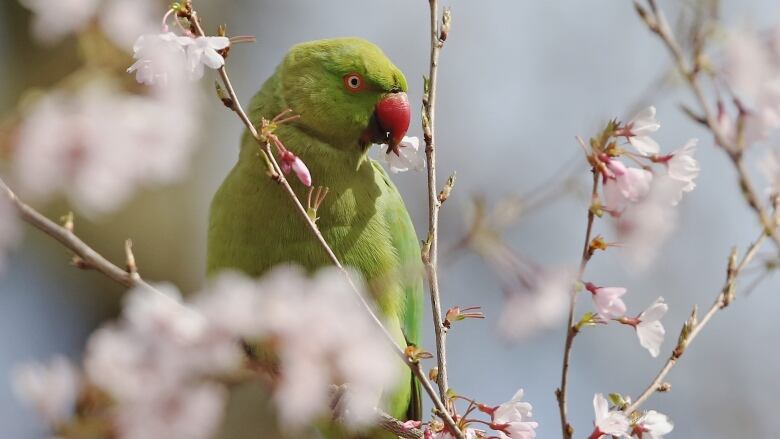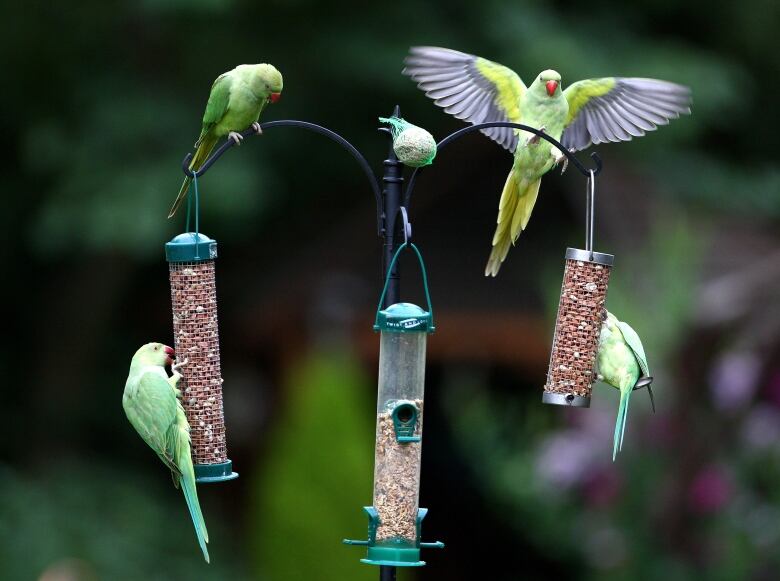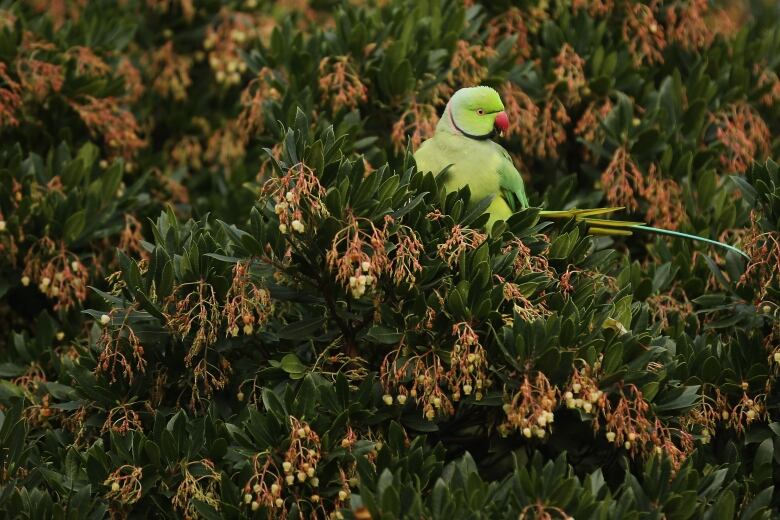Feral parakeets taking over London, prompting concerns they'll push out native birds
Some 8,600 breeding pairs of ring-necked parakeets live in the U.K., a species not native to the country

Reclining in the chair of his home office in Farnham, England, Keith Betton says he'd be happy to look out and see one and only one ringed-neck parakeet feeding from his backyard birdfeeder.
"I don't particularly wish to have non-native species in Britain," says the 55-year-old, an avid bird-watcher since childhood and vice-president of the British Trust for Ornithology. "If I could choose to never have them arrive, that would be my choice, but they are here."
- AS IT HAPPENS:London tries to get rid of its feral parakeets
- Python hunters target invasive snakes overrunning Florida Everglades
- Mussel-sniffing dogs keeping invasive species out of Alberta
- Will efforts to keep Asian carp out ofGreat Lakes work?
In London, parakeets are everywhere and their populations are spreading throughout the U.K. and Europe, prompting concerns the invasive species could harm native ecosystems.
Betton, who lives about 40 kilometres southwest of London, says he wouldn't feel dismayed if the invasive birds were to settle near his country home, but he wishes the birds had never been introduced to the U.K. in the first place.
"It's a big stage entrance when they arrive," says Betton. "They are like the person who walks in the room, makes too much noise and then leaves."

The ring-necked parakeet or rose-ringed parakeet as it is sometimes called is hard to miss. Bright green with a striking red beak, long tail and signature pink and black band along the neck, the ring-necked parakeet is an active and very loud bird.
Many people think the parakeets are cute and keep them as pets. But when they escape or are deliberately released, they have an uncanny ability to adapt and thrive in the wild.
The U.K. Department for Environment, Food and Rural Affairs (DEFRA) estimates there are 8,600 breeding pairs of ring-necked parakeets in the U.K., and if they are thriving in the wild, there is a chance they are pushing out native birds.
"There is ... potential for biodiversity impacts through competition for resources, although the evidence for this is less clear," DEFRA spokeswoman Issy Antenen told CBC in an email.
Given the size of the ring-necked parakeet population, however, Antenen says it is not cost-effective or viable to rehome them.
Is Jimi Hendrix responsible?
Exactly how the birds arrived in London is the topic of often-fantastical theories and myths.
Jimi Hendrix is said to have released an "Adam and Eve" couple from Carnaby Street in the 1960s. Others claim the first parakeets were escapees of Isleworth Studios during the filming of the 1951 film The African Queen.
Some even hypothesize the parakeets escaped from the London Zoo when it was damaged during the London Blitz by the Nazis, between September 1940 and May 1941.

For Betton, the parakeet is a quirky foreign presence that has long lost its novelty.
"I just saw a few now and again, but ... did not see them very often. I didn't become very aware of them in London until the 1980s," says Betton, who is also a bird recorder for Hampshire County.
Bird recorders collate notes and bird sightings to create a historical record of bird distributions, breeding patterns and movements.
London has been aggressively colonized by the feral parakeet since the late 1960s. Walk through any city park today and their sharp, piercing squawks sounding like a mix between a chirp and a squeaky dog toy carry from tree to tree.
At the start of their London conquest, the parakeets spread clockwise from the city's southwest, moving into regions with bird feeders and large gardens, says London's county bird recorder Andrew Self.
Now the parakeets are slowly expanding beyond London but are dependent on densely populated centres for food and shelter.
Love 'em or hate 'em
Among bird enthusiasts in the U.K., there are two camps: you either hate the parakeet or you don't.
"I quite enjoy having the parakeets around," says Self. "They are quite different from your average bird. They are very noisy and they remind me of the time I went to India to bird watch. The real novelty ... is for those who are not bird watchers watching them in their gardens."
Genetically, the U.K.'s parakeets hail from regions in Pakistan with similar climates to the U.K. and Europe.
The ring-necked parakeet is the fastest growing bird species in the U.K., according to Hazel Jackson, a postdoctoral research associate at the University of Kent's Durrell Institute of Conservation and Ecology who studies the bird's biodiversity and expansion.
It is also considered one of the most successful invasive species in the world.
In Europe alone, there are 65 breeding populations not only in the U.K., but also in Spain, Germany, Turkey and the Netherlands.

Jackson says the biodiversity of the U.K. parakeet population suggests the birds were introduced into the wild more than once.
Canada, too, has wild parakeets, known as Monk or Quaker parakeets. They live near the St. Lawrence River basin, according to the Canadian Wildlife Federation. Monk parakeets are also found in London though they number fewer than 100.
Tracking the birds
Despite their history in Europe, little is known about the ecological impact of the ring-necked parakeet, so the scientific community is increasingly placing the species under the microscope.
ParrotNet an online network of 70-plus European scientists and policy-makers launched two years ago, aiming to track the geographic spread and ecological impact of non-native parrot species, including the parakeet.
"I'm on the fence about the impact they are having. They've been in the U.K. for 45 years now. If they were to have an impact, we would have noticed," says Jackson, adding that measuring such results in a heavily urbanized environment is difficult to do.
The U.K. parakeets have a varied diet, eating everything from seeds and nuts, to fruit and berries, even household scraps and grain, according to the Royal Society for the Protection of Birds.

As their numbers increase, they could pose a problem for local agriculturalists.
In 2002, parakeets were responsible for eating one tonne of grapes roughly one-third of the harvest at the Painshill Park vineyard, located southwest of central London.
After being added to the general licence in 2009, British landowners are now permitted to cull parakeets if they're causing serious damage to crops a move that put the brightly coloured birds on the same footing as pigeons, crows and magpies, other species considered pests.
Unnatural presence?
Self says he has heard observations about the parakeets evicting native birds from their nesting sites, but nothing that would suggest native bird populations in the U.K. are dropping due to the parakeet.
A 2014 behavioural ecology study, however, concluded the U.K.'s native bird species spend less time feeding and are more vigilant when in the presence of the larger, more socially dominant parakeet.
For many others naturalists, including Betton, the parakeets' presence in the U.K. is unnatural and shows mankind's way of tinkering with natural ecosystems.
"A bird getting here on its own strength is fine," says Betton, who has yet to record a parakeet sighting inHampshire County.
For now he waits, if perhaps a little wary, for the day a brave bird ventures near.
"I'm not against them," he says. "I do think it is a beautiful-looking bird. If it was a rare bird and it flew over you, you'd be pretty excited. And I probably would have that feeling when I was 13 and saw my very first one."












_(720p).jpg)


 OFFICIAL HD MUSIC VIDEO.jpg)
.jpg)



























































































